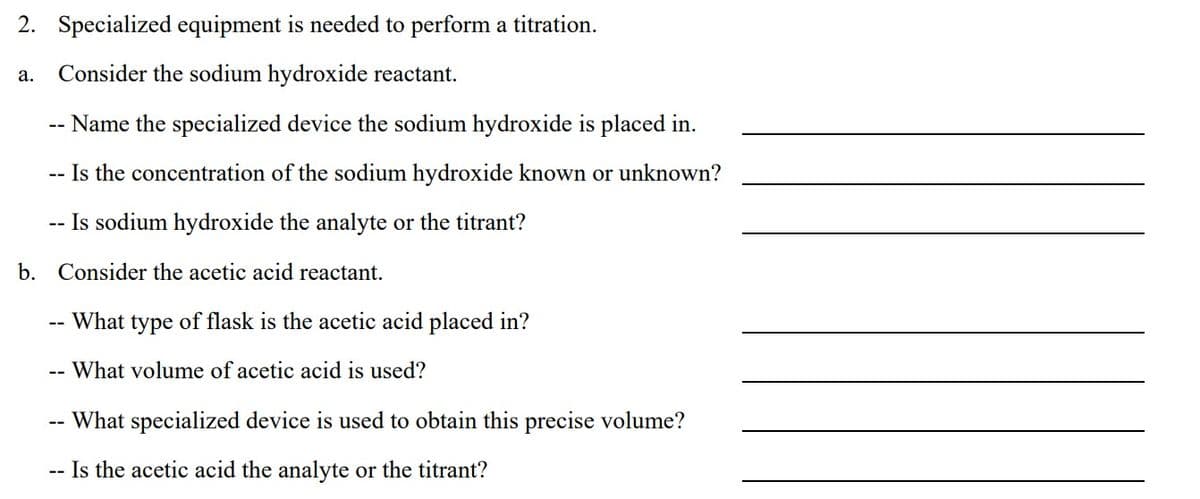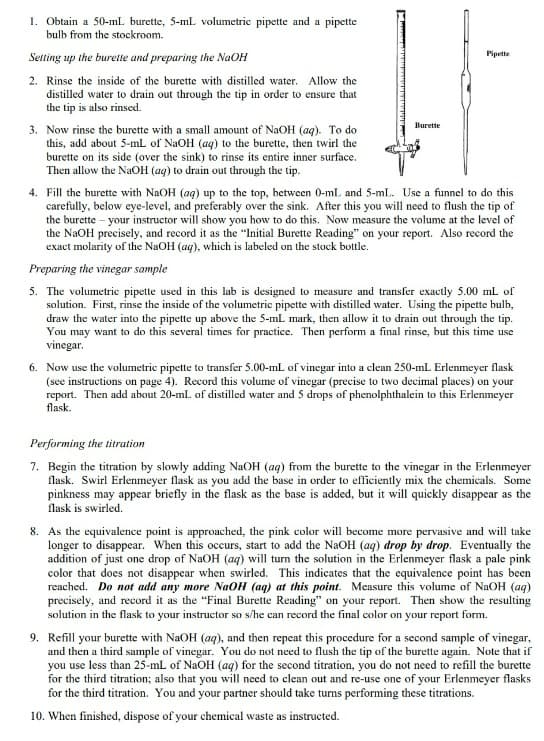2. Specialized equipment is needed to perform a titration. a. Consider the sodium hydroxide reactant. - Name the specialized device the sodium hydroxide is placed in. -- Is the concentration of the sodium hydroxide known or unknown? -- - Is sodium hydroxide the analyte or the titrant? b. Consider the acetic acid reactant. - What type of flask is the acetic acid placed in? -- What volume of acetic acid is used? -- What specialized device is used to obtain this precise volume? -- Is the acetic acid the analyte or the titrant?
2. Specialized equipment is needed to perform a titration. a. Consider the sodium hydroxide reactant. - Name the specialized device the sodium hydroxide is placed in. -- Is the concentration of the sodium hydroxide known or unknown? -- - Is sodium hydroxide the analyte or the titrant? b. Consider the acetic acid reactant. - What type of flask is the acetic acid placed in? -- What volume of acetic acid is used? -- What specialized device is used to obtain this precise volume? -- Is the acetic acid the analyte or the titrant?
Chapter7: Solutions And Colloids
Section: Chapter Questions
Problem 7.36E
Related questions
Question

Transcribed Image Text:2. Specialized equipment is needed to perform a titration.
a. Consider the sodium hydroxide reactant.
Name the specialized device the sodium hydroxide is placed in.
-- Is the concentration of the sodium hydroxide known or unknown?
-- Is sodium hydroxide the analyte or the titrant?
b. Consider the acetic acid reactant.
--
--
What type of flask is the acetic acid placed in?
What volume of acetic acid is used?
What specialized device is used to obtain this precise volume?
-- Is the acetic acid the analyte or the titrant?

Transcribed Image Text:1. Obtain a 50-ml burette, 5-mL volumetric pipette and a pipette
bulb from the stockroom.
Setting up the burette and preparing the NaOH
2. Rinse the inside of the burette with distilled water. Allow the
distilled water to drain out through the tip in order to ensure that
the tip is also rinsed.
3. Now rinse the burette with a small amount of NaOH (aq). To do
this, add about 5-mL of NaOH (aq) to the burette, then twirl the
burette on its side (over the sink) to rinse its entire inner surface.
Then allow the NaOH (aq) to drain out through the tip.
M
Burette
Pipette
4. Fill the burette with NaOH (aq) up to the top, between 0-mL and 5-ml. Use a funnel to do this
carefully, below eye-level, and preferably over the sink. After this you will need to flush the tip of
the burette - your instructor will show you how to do this. Now measure the volume at the level of
the NaOH precisely, and record it as the "Initial Burette Reading" on your report. Also record the
exact molarity of the NaOH (aq), which is labeled on the stock bottle.
Preparing the vinegar sample
5. The volumetric pipette used in this lab is designed to measure and transfer exactly 5.00 mL of
solution. First, rinse the inside of the volumetric pipette with distilled water. Using the pipette bulb,
draw the water into the pipette up above the 5-mL mark, then allow it to drain out through the tip.
You may want to do this several times for practice. Then perform a final rinse, but this time use
vinegar.
6. Now use the volumetric pipette to transfer 5.00-mL of vinegar into a clean 250-mL Erlenmeyer flask
(see instructions on page 4). Record this volume of vinegar (precise to two decimal places) on your
report. Then add about 20-mL of distilled water and 5 drops of phenolphthalein to this Erlenmeyer
flask.
Performing the titration
7. Begin the titration by slowly adding NaOH (aq) from the burette to the vinegar in the Erlenmeyer
flask. Swirl Erlenmeyer flask as you add the base in order to efficiently mix the chemicals. Some
pinkness may appear briefly in the flask as the base is added, but it will quickly disappear as the
flask is swirled.
8. As the equivalence point is approached, the pink color will become more pervasive and will take
longer to disappear. When this occurs, start to add the NaOH (aq) drop by drop. Eventually the
addition of just one drop of NaOH (aq) will turn the solution in the Erlenmeyer flask a pale pink
color that does not disappear when swirled. This indicates that the equivalence point has been
reached. Do not add any more NaOH (aq) at this point. Measure this volume of NaOH (aq)
precisely, and record it as the "Final Burette Reading" on your report. Then show the resulting
solution in the flask to your instructor so s/he can record the final color on your report form.
9. Refill your burette with NaOH (aq), and then repeat this procedure for a second sample of vinegar,
and then a third sample of vinegar. You do not need to flush the tip of the burette again. Note that if
you use less than 25-mL of NaOH (aq) for the second titration, you do not need to refill the burette
for the third titration; also that you will need to clean out and re-use one of your Erlenmeyer flasks
for the third titration. You and your partner should take turns performing these titrations.
10. When finished, dispose of your chemical waste as instructed.
Expert Solution
This question has been solved!
Explore an expertly crafted, step-by-step solution for a thorough understanding of key concepts.
This is a popular solution!
Trending now
This is a popular solution!
Step by step
Solved in 2 steps with 2 images

Knowledge Booster
Learn more about
Need a deep-dive on the concept behind this application? Look no further. Learn more about this topic, chemistry and related others by exploring similar questions and additional content below.Recommended textbooks for you


Macroscale and Microscale Organic Experiments
Chemistry
ISBN:
9781305577190
Author:
Kenneth L. Williamson, Katherine M. Masters
Publisher:
Brooks Cole

Chemistry: Matter and Change
Chemistry
ISBN:
9780078746376
Author:
Dinah Zike, Laurel Dingrando, Nicholas Hainen, Cheryl Wistrom
Publisher:
Glencoe/McGraw-Hill School Pub Co


Macroscale and Microscale Organic Experiments
Chemistry
ISBN:
9781305577190
Author:
Kenneth L. Williamson, Katherine M. Masters
Publisher:
Brooks Cole

Chemistry: Matter and Change
Chemistry
ISBN:
9780078746376
Author:
Dinah Zike, Laurel Dingrando, Nicholas Hainen, Cheryl Wistrom
Publisher:
Glencoe/McGraw-Hill School Pub Co